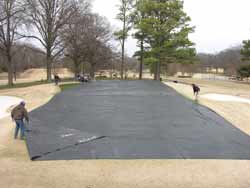An Ultradwarf Bermudagrass Alert
Winter injury is the number one threat to bermudagrass putting greens in the Southeast Region. With the number of bermudagrass courses in the region growing each year, the impact on the game of golf from a cold winter could be devastating to a golf course that is not prepared to protect their bermudagrass putting greens. There is an old saying that an ounce of prevention is worth a pound of cure. This idea holds true in the world of bermudagrass putting greens, too.
The ounce of prevention for winter injury is the use and proper deployment of turfgrass covers. Despite the repeated comments we hear about climate change and the ability to afford turf covers, winter injury is not an area to ignore. Losing this gamble is expensive in more ways than one. First, serious winter injury is going to take your golf course out of play for an extended period of time. Second, there may not be available grass for purchase. Phone conversations with growers have indicated that bentgrass to ultradwarf conversions are increasing and most, if not all, of their planting stock is sold out for 2009 and 2010. Dead turf from winter injury and the lack of an available supply for purchase would be a major problem.
 |
|
| Covering ultradwarf bermudagrass putting greens when conditions warrant is vital to protect against winter injury | |
We will cut to the chase and describe what is needed to be best prepared to prevent winter injury and a minimalist plan.
Option 1: Purchase covers for all the putting greens on your course. There are available sources of lightweight covers that are much easier to deal with then the old, heavy spun-bound blankets of the 1970's and 1980's. For information on deploying turf covers, please refer to the Nov/Dec issue of the Green Section Record and the article called "Ultradwarfs in the Off Season - A Winter Wonderland." The link is /content/dam/usga/pdf/imported/071101.pdf .
Option 2: If money is not available to purchase covers for 18 or 19 greens, obtain three or four covers and protect three or four greens. Why? Because if there is catastrophic loss of putting green turf and turf producers are sold out, your course will have an available supply of plant material to begin planting dead/weak greens. How much plant material is available from three or four greens? We don't know, but probably enough to get at least nine holes restored.
There are plenty of questions associated with Option 2. Should you cover your three strongest putting greens or your three weakest putting greens? Should you cover the largest or smallest putting greens? Great questions to ask, but there are no simple answers here.
This update has touched briefly on this important topic. For more information and assistance specific to your course, please contact either of us at the numbers or email listed below.
Source:
Patrick O'Brien 770-229-8125 or
patobrien@usga.org
and Chris Hartwiger 205-444-5079 or
chartwiger@usga.org
